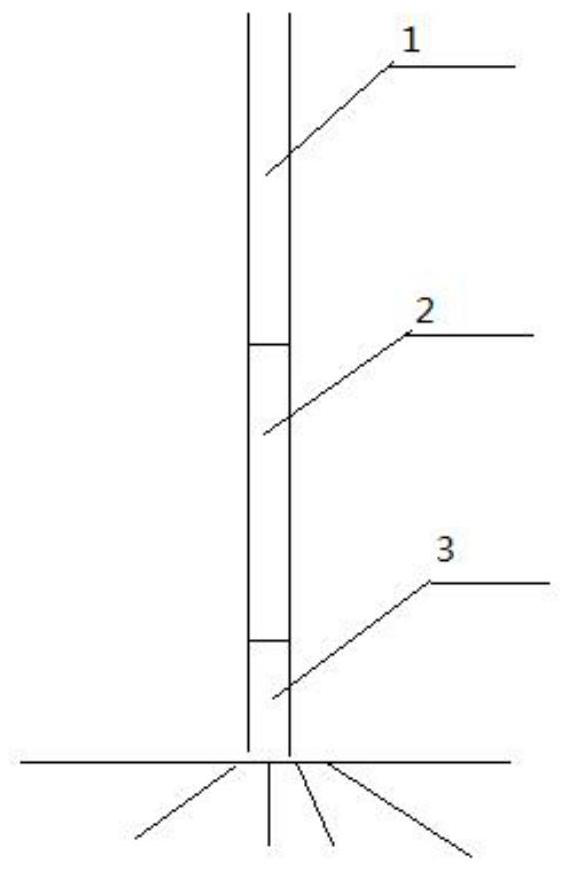Seedling breeding method of almonds
A technology for almonds and seedlings, applied in botany equipment and methods, horticulture, agriculture, etc., can solve the problems of low kernel yield, tree body weakness, and dead plants, and achieve the improvement and extension of peach stone yield and kernel yield The effect of tree life and incidence reduction
- Summary
- Abstract
- Description
- Claims
- Application Information
AI Technical Summary
Problems solved by technology
Method used
Image
Examples
Embodiment 1
[0027] In the spring of 2015, an experimental garden was set up in Xiya Village, Jinshan Town, Linzi District, Zibo City, Shandong Province for planting. The specific method is: use peaches as the base stock, mountain peaches as the middle stock, and American almond almond Napril, with 5 plants as a group. Establish 3 groups altogether in the different positions of test garden; Seedlings are grafted according to the method as follows:
[0028] (1) Cultivation of rootstock: choose the raw peach seedlings as the base stock, take out the sand-treated peach seeds in late February, and sow them according to the conventional seedling raising method, with 4 rows per border, density: row spacing 40 cm, plant spacing 20 cm, after emergence Strengthen the management of fertilizer and water, and graft the peach rootstock when the height is 40 cm and the thickness is more than 0.3 cm;
[0029] (2) Grafting of the middle rootstock of the mountain peach: In the first ten days of June of tha...
Embodiment 2
[0033] In the spring of 2015, an experimental garden was set up in Xiya Village, Jinshan Town, Linzi District, Zibo City, Shandong Province for planting. The specific method is: use peaches as the base stock, mountain peaches as the middle stock, and American almonds Prius grafted, with 5 plants as a group, in the There are 3 groups in different positions of the test garden; the seedlings are all grafted according to the following methods:
[0034] (1) Cultivation of rootstock: choose the raw peach seedlings as the base stock, take out the sand-treated peach seeds in late February, and sow them according to the conventional seedling raising method, with 4 rows per border, density: row spacing 40 cm, plant spacing 20 cm, after emergence Strengthen the management of fertilizer and water, and graft the peach rootstock when the height is 40 cm and the thickness is more than 0.3 cm;
[0035] (2) Grafting of the middle rootstock of the mountain peach: In the first ten days of June o...
Embodiment 3
[0038] The almond kind among the embodiment 1 is changed into Moser and carries out grafting, and other is all identical with embodiment 1.
[0039]The seedlings of embodiment 1-3 field planting are managed by conventional methods, and in 2018 (4 years old) the test garden is followed up and investigated, and the results show that the growth results of 3 almond varieties in embodiment 1-3 are all normal, and in 2018 ( No root rot occurred in 4-year-old trees)-2020 (6-year-old trees), and no trunk gummosis occurred in 2018 (4-year-old trees)-2019 (5-year-old trees). In 2020, there was only one Prius Slight glue flow occurred due to mechanical injury, and the tree mortality rate was 0%. (See pictures of tree shapes image 3 . )
PUM
 Login to View More
Login to View More Abstract
Description
Claims
Application Information
 Login to View More
Login to View More - R&D
- Intellectual Property
- Life Sciences
- Materials
- Tech Scout
- Unparalleled Data Quality
- Higher Quality Content
- 60% Fewer Hallucinations
Browse by: Latest US Patents, China's latest patents, Technical Efficacy Thesaurus, Application Domain, Technology Topic, Popular Technical Reports.
© 2025 PatSnap. All rights reserved.Legal|Privacy policy|Modern Slavery Act Transparency Statement|Sitemap|About US| Contact US: help@patsnap.com



